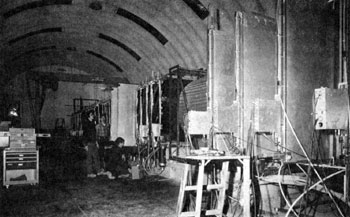Caltech Group Detects Neutrinos

(L-R) Dave Buchholz, Henrl Suter and Dennis Shields stand at the downstream end of the 170-ton neutrino target. The neutrino beam enters the apparatus through the wall at the rear of the photo. In the foreground are large-area spark chambers, used for the detection of muons resulting from the neutrino interaction
In 1971, NAL Director Robert R. Wilson told the Users' Organization that "one of the first alms of experiments on the NAL accelerator system will be the detection of a neutrino. I feel that we then will be in business to do experiments on our accelerator..."
Neutrinos, which have neither charge nor mass, are very difficult particles to detect experimentally. They play a very prominent role in the study of the weak interaction, because they only interact via the weak force, about which relatively little is known.
Months have passed since this comment was made, many long hours have been devoted to completing and refining the NAL accelerator, and Dr. Wilson's wish for the detection of a neutrino has been fulfilled. The Experiment 21 group, headed by Professors Barry Barish and Frank Scuilli, from the California Institute of Technology, detected neutrinos in their apparatus last November. They are making tests in the neutrino beam in anticipation of measurements they hope to pursue in 1972. It was an exciting time for all those connected with the experiment. At the February 7th Director's Meeting, Dr. Barish described recent developments in the Wonder Building:
"As most people know, in November 1971 we first saw neutrinos, which at that point wasn't much more than proving to us that the accelerator really existed and something came out. We were set up in a mode where all we could do was see neutrinos interact -- we couldn't even attempt to look at the properties of high energy neutrino interactions. We were over-constraining ourselves in as many ways as possible, in order to make sure that we could really detect neutrinos and believe it.
By January 1972... fortunately the energy of the machine went up to 300 GeV and we got something like 3 x 1016 protons on our target, which gave us our first opportunity to obtain a reasonable number of events. Quite a few people who were around here at the time actually saw events coming in. At one time, for example, we had two events on successive pulses, which seems to be a record.
Since then we looked very hard at what we had. We saw some examples of neutrino interactions of over 100 GeV. Over half of our events were analyzable, and for a first attempt, that's encouraging. We know what we have to do to get at the rest, and we're just in the process of trying to understand and improve the apparatus, beam, and so forth. We have lots of tests to make, but I don't think it will be very long before we'll be able to say something. Right now, however, we remain very, very silent."
The Caltech group conducted more tests to be sure their apparatus was working properly and determined which "pieces of physics" were sensible to pursue with it, and then finally, to complete the experiment.
Their experiment was assembled with the help and support of the NAL Neutrino Section. The Caltech experimenters consisted of a small, dedicated group. Dennis Shields built and installed much of the equipment one sees in the Wonder Building. The sophisticated ON-LINE data acquisition system used in the experiment was developed by Fritz Bartlett. George Krafczyk of NAL made important contributions to almost every facet of the experiment. David Buchholz and Henri Suter, (a CalTech visitor from University of Geneva) joined the experiment, adding both new stimulation and an international flavor to the group. Al Maschke, from Brookhaven National Laboratory and Yori Nagashima, who has returned to Japan, also contributed. CalTech thesis students, Tom Humphrey and Frank Merritt, were the real heart and soul of the experiment.
What the group next hopes to investigate is the behavior of the weak interaction - force - at the very high energies possible with the NAL accelerator.
The weak interaction has been studied extensively in decays of unstable particles and radioactive nuclei, in which the energy released is in the range of approximately zero to 500 MeV. For a number of theoretical reasons, physicists expect that the picture of the weak interaction which has emerged from such particle decay experiments will change when higher energies are used, although the precise nature of the change remains conjecture. New phenomena, or even a new particle, may be discovered. No carrier of the force - a field particle, so to speak - has as yet been identified for the weak interaction, although the so-called W-particle or intermediate vector boson has been postulated. It just might be produced at higher energies. Nobody knows.
Experiments at CERN using neutrinos at energies up to 10 GeV showed no noticeable deviation from the known theory of weak interactions. Neutrino physics is so interesting and exciting that several other experiments were approved, including those for the 15-foot Bubble Chamber.
Whether the NAL accelerator, which yields neutrino energies more than ten times greater than any studied to date, will provide enough energy to see any new phenomena or to prove the existence of the W-particle and thus, further explain this puzzling nuclear force, remains to be seen.
If it does, as Dr. Wilson enthusiastically remarked at that same Director's Meeting, "just that one thing will make the whole Laboratory worthwhile."


